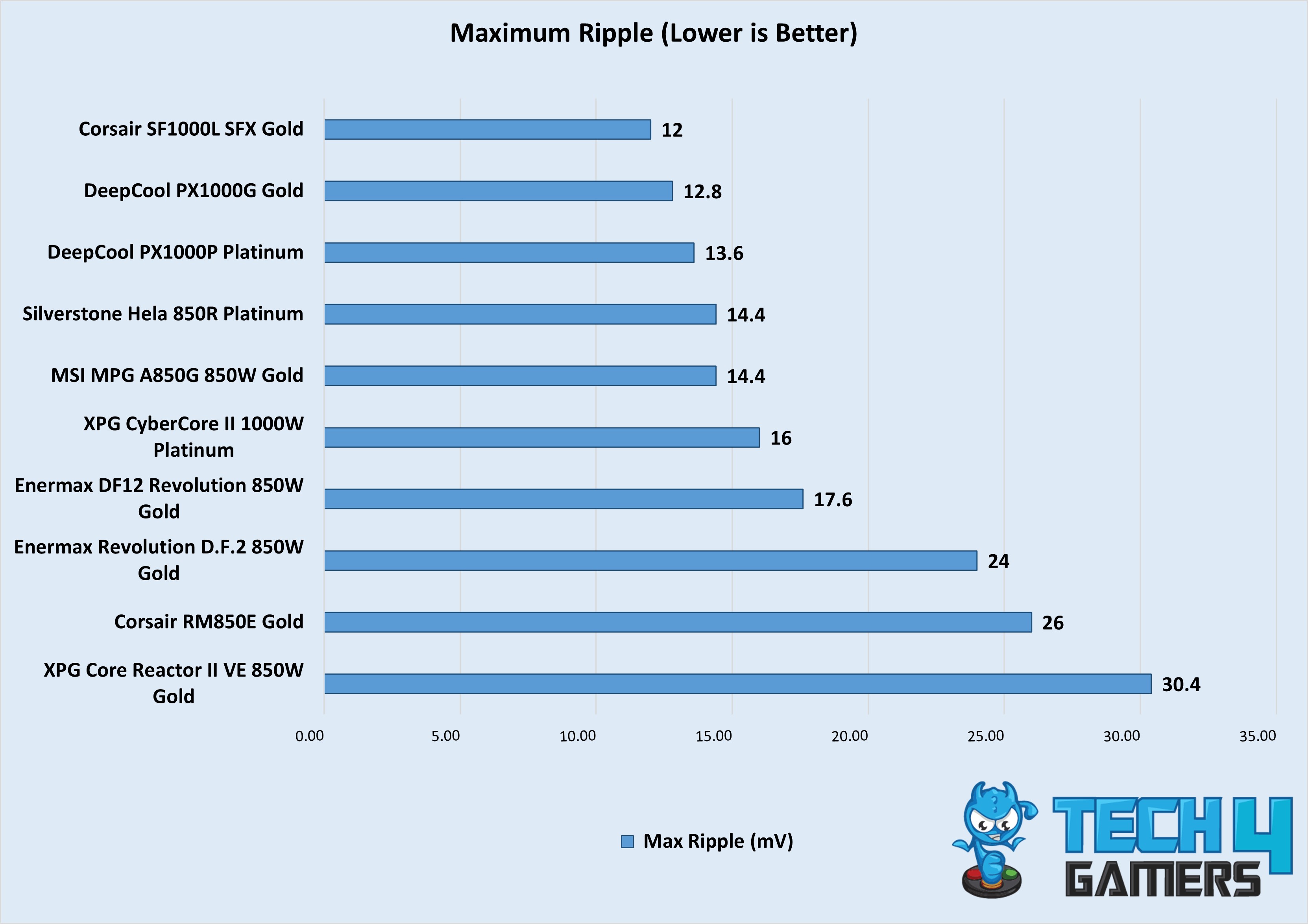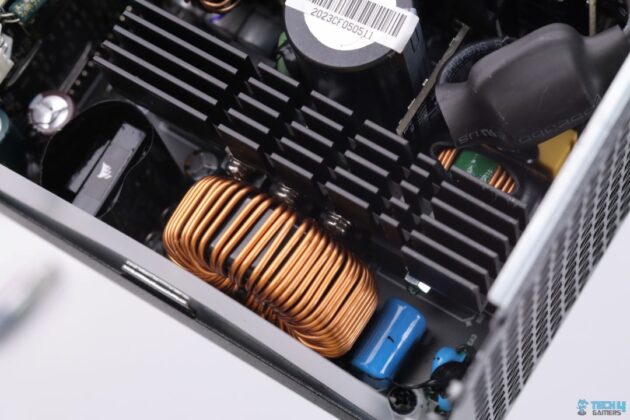Affordable Power With A Few Compromises!
Review Summary
The Corsair RM850e is an affordable ATX 3.0 PSU perfect for budget-conscious gamers, delivering solid performance and reliability. While it uses non-Japanese capacitors and a rifle-bearing fan, it still offers impressive efficiency and acceptable voltage regulation. Its compact, fully modular design makes it versatile for ATX builds. However, the lack of a native 12VHPWR connector and average voltage ripple performance might disappoint some. Overall, the RM850e is a great value for gamers on a budget.
Hours Tested: 13
Overall
-
Performance - 8.9/10
8.9/10
-
Build Quality - 9/10
9/10
-
Efficiency - 9/10
9/10
-
Value - 8/10
8/10
Pros
- High efficiency.
- Budget-friendly.
- 7 years of warranty.
Cons
- No Hybrid Fan mode.
- No 12VHPWR native connector
The latest PSU specifications from Intel in the form of ATX 3.0 and ATX 3.1 resulted in an increased power density to compensate for extremely high power excursions or power spikes generated by the latest GPUs and CPUs. But sadly, there has also been a significant spike in PSU prices lately. Corsair with their recent RMe series PSUs (not to be confused with RMx series) is trying to launch affordable ATX 3.0 spec PSUs ranging from 750W, 850W & 1000W.
The budget-oriented PSU segment has recently been caught up with a greater pace by many manufacturers thanks to Intel’s leniency for its ATX 3.1 specs which now allows PSUs to have slightly loose tolerances for Voltage Regulation and Hold-up time.
Key Takeaways
- The Corsair RM850e Gold is a budget-friendly, fully modular ATX 3.0 PSU offering solid performance and reliability, ideal for cost-conscious gamers.
- You should buy the Corsair RM850e Gold if you want a bang-for-the-buck PSU that offers stable performance for a high-end gaming PC.
- However, you should skip the RM850e Gold if you plan to upgrade your PC soon and your wattage requirement will exceed 850W. Plus, the fans get noisy as well.
Here are the specifications:
| Cybenetics Efficiency | Gold |
| Cybenetics Noise | A- |
| ATX12V Version | 3.1 |
| Continuous Power W | 850 Watts |
| Fan Bearing Technology | Rifle Bearing |
| Fan Size MM | 120mm |
| Modular | Fully |
| MTBF Hours | 100,000 hours |
| PSU Form Factor | ATX |
| Zero RPM Mode | Yes |
| 80 PLUS Efficiency | Gold |
| Warranty | 7 Year |
| Weight | 2.738 KG |
Packaging & Unboxing
I have tested many PSUs from Corsair, and the RM850e packaging and styling fit right into their team. The front of the yellow box has a big picture of the PSU’s design, showcasing its vents and modular bay.
At the back, you’ll find all the main features written in multiple languages alongside Cybenetics and 80+ brand logos.
The power supply is protected with black foam. This is a standard measure that I have seen in pretty much all power supplies. The cables and the PSU come in a plastic pouch.
Design
The RM850e Gold measures 140x150x86mm. It can easily work in any ATX chassis without any issues. The front of the power supply has triangular vents. I don’t know how I feel about the fan blades being the same color as the PSU casing. Most brands go for some accent designs.
The PSU side has a big RM850E branding alongside the Corsair logo. At the back, you can read all the regulatory information and power specifications.
Cable & Connectors

Only the 24-pin ATX cable is sleeved, the rest are standard flat cables. Seeing that the RM850e PSUs are always aimed at budget gamers, the lack of sleeved cables is not that big of a deal.
Here is the list of all connectors:
| Cable Type | Quantity |
|---|---|
| ATX Connector | 1 |
| EPS Connector | 2 |
| SATA Connector | 7 |
| PATA Connector | 4 |
| PCIe Connector | 3 |
As I have already expressed my disappointment in my Corsair HX1200i review for not having a native 12VHPWR connector, I will try not to criticise Corsair anymore because this time they may have done this for cost savings which hopefully they’re going to invest in native 12VHPWR connectors in their latest upcoming PSUs (I said I will try).
Teardown & Component Analysis

We have seen Corsair’s heavy reliance on CWT for many of its PSUs, this time they went with an OEM that’s famous for its budget-friendly platforms HEC.
HEC has also made a few PSUs in the past for Corsair such as Corsair CV & Corsair CXF series and as we already know Corsair specifically asks its OEMs for slight design tweaks for their PSUs, I personally am pretty sure that we will not be witnessing some eyebrow-raising compromises in an effort to keep the cost low.
There’s a single block of aluminium heatsink which cools down all the Primary side components such as Bridge Rectifiers, APFC MOSFETs and its Boost Diode. It’s always good to see OEMs use fully potted APFC Inductors for reduced coil whine but sadly this isn’t the case here. Though we did not notice any coil whine during our extensive test so this isn’t a big deal I guess.
2 MOSFETs that drive the main transformer are mounted on their separate heatsink and they together make Half-Bridge topology.
Overall the design seems to allow adequate room for air to flow properly with not much of a hindrance and effectively cool down all the internal components.
When I saw “7 years of warranty” on the box, the first thing that came to my mind was “so that’s where the cost-cutting went” because if a PSU is not marketed with 10 years of warranty, (which has become quite a common practice these days for Gold and above-rated PSUs) the reason has got to be the use of non-Japanese capacitors, and I was actually right!
High-end Japanese capacitors heavily affect the final cost. It is also really important to note that there are a few Taiwanese capacitors that have managed to match the performance of some well-known Japanese capacitors and among them is Elite which many manufacturers believe to be the best alternative to the Japanese capacitors. I can not say the same for Teapo though. There are also many Polymer capacitors for voltage filtering from the above-mentioned brands.
The main transformer is fully potted with resin, most likely to silence the switching noises. In order to decrease conversion losses, the 12V MOSFETs board is directly soldered to the transformer. For just an 850W PSU, it’s quite unusual to see a flat aluminium heatsink covering 12V MOSFETs with a layer of thermal pad sandwiched in between. HEC & Corsair don’t seem to skip even this tiny detail to avoid increased temperature.
The fan is from Hong Hua but instead of using their superior quality Fluid Dynamic Bearing fan, Corsair has opted for a Rifle Bearing Fan as a cost-saving measure.
PSU Load Testing

12V & Minor Voltage Rails Regulation

| Load in % | 12V | 5V | 3.3V |
|---|---|---|---|
| 20% | 12.06V | 5.00V | 3.30V |
| 50% | 12.00V | 4.99V | 3.30V |
| 70% | 11.96V | 4.99V | 3.29V |
| 90% | 11.92V | 4.99V | 3.29V |
| 100% | 11.91V | 4.98V | 3.28V |
Voltage regulation is not that impressive. I have seen better results in similar price offerings.
It’s important to note that for an end-user this shouldn’t be of any concern, tight voltage regulation defines a better design aspect of a PSU which a reviewer like me gives higher preference especially if we are getting better results from competitors.
PSU Efficiency

| Load in % | Efficiency | Power Factor |
|---|---|---|
| 20% | 90.81% | 0.911 |
| 50% | 93.20% | 0.957 |
| 70% | 92.85% | 0.968 |
| 90% | 92.12% | 0.974 |
| 100% | 91.59% | 0.977 |
The Corsair RM850e is well-tuned for its efficiency and easily achieves Gold-rated levels of performance without struggling much.
Voltage Ripple Performance

| Load in % | Voltage Ripple |
|---|---|
| 20% | 26mV |
| 50% | 16.8mV |
| 70% | 17.6mV |
| 90% | 19.2mV |
| 100% | 21.6mV |
Just as we saw the effects of cost-cutting in our previous test, similarly Corsair RM850e’s voltage ripple performance doesn’t seem to reflect the high standards set by Corsair either. But if we think of RM850e for its high affordability, then these numbers become quite impressive.
Temperatures
Due to its average efficiency of 92% and fan spinning all the time, the operation has been much cooler throughout.
Should You Buy it?
Buy it if
✅You are tight on the budget: If you have already spent most of your budget on a decent Gaming PC with Ryzen 7 7700X & RTX4080 (or similar TDP system) and have no further upgrade plans for your PC.
Don’t Buy it if
❌You plan to upgrade soon: There is not enough output power for upgrading to high-end components later down the line.
❌You want quieter operations: Being only limited to 850W, you will mostly be using RM850e to its 25% capacity even on normal use, which can spin the fan to audible levels.
My Thoughts
Corsair with its RMe series lineup, provides a superb price to performance PSU for the tight-on-the-budget Gamers who want to have better protection and peace of mind for their beloved Gaming PCs.
Community Poll
Coming Next: MSI MPG A850G 850W Review
Thank you! Please share your positive feedback. 🔋
How could we improve this post? Please Help us. 😔
[Errors Troubleshooting Expert]
Arsalan Shakil (aka GuyThatDoesEverything on YouTube) is a PC Tech Enthusiast and Electronic Geek. With over 10+ years of experience in Electronics, he then decided to explore Software Engineering to design embedded products and automate existing hardware solutions.
When he started tearing down old cameras to understand how they worked, he was shocked (literally, when he got zapped by a flash discharge capacitor), giving him the power (debatable) to fall in love with videography/photography. He also started making some fun videos that later became YouTube tech reviews.
Skills:
- 10+ years of experience in Electronics design, embedded solutions, and prototyping
- Majored in Software Engineering
- Research paper publication in IEEE for Embedded Military Uniform & LoRa WAN wireless technology
- Specialized in IoT Solutions
- PC Enthusiast & PC Modder
In his local region, he’s known to expose cheap PSU brands, often claiming fake certification or false claims on the box. He’s a true nerd and needed some friends in his life. Then he met some guys who work at Tech4Gamers, and they also came out to be equal nerds who suggested he join Tech4Gamers as a Hardware Expert.


 Threads
Threads

























